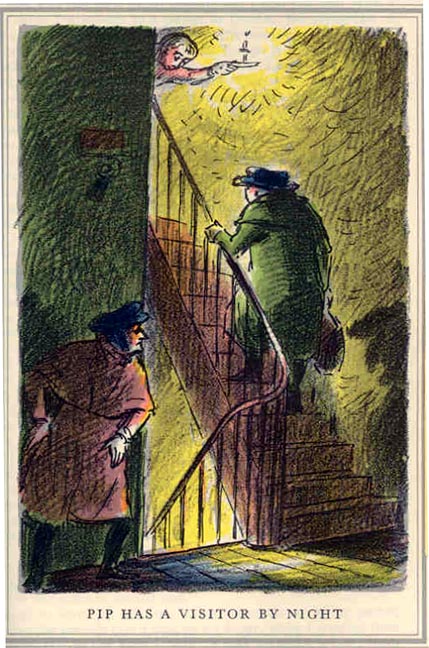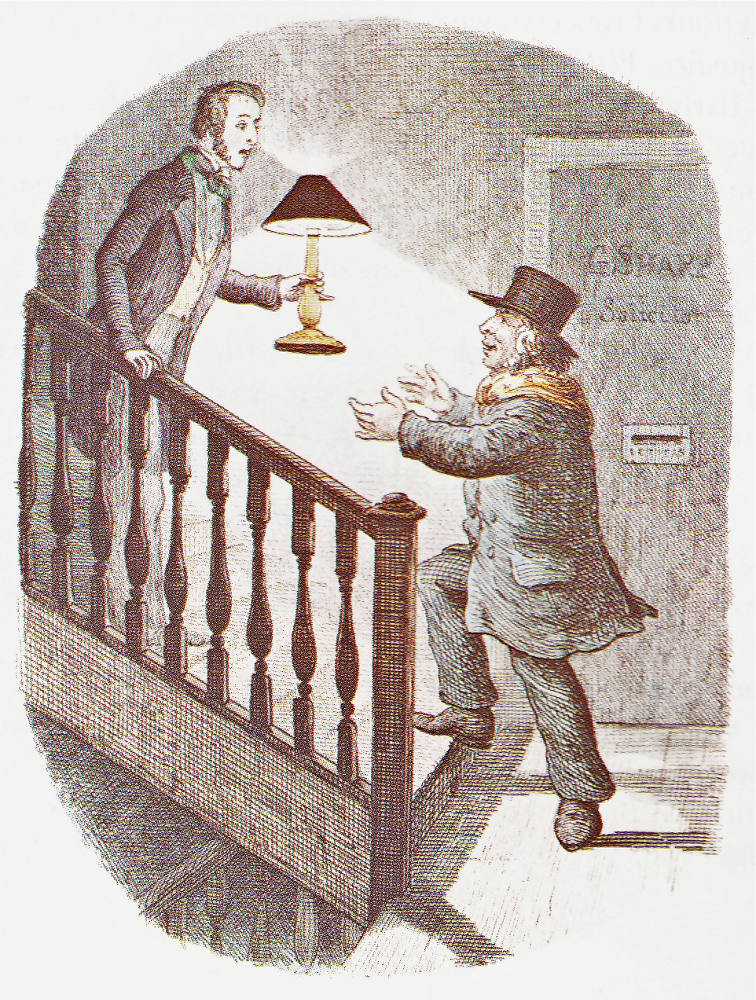The Convict's Return
Felix O. C. Darley
1861
Photogravure
9.9 x 8.5 cm vignetted
Dickens's Great Expectations, Household Edition (New York, 1861), vol. 2 frontispiece.
[Click on image to enlarge it.]
Scanned image and text by Philip V. Allingham.
[Victorian Web Home —> Visual Arts —> Illustration —> F. O. C. Darley —> Next]
The Convict's Return
Felix O. C. Darley
1861
Photogravure
9.9 x 8.5 cm vignetted
Dickens's Great Expectations, Household Edition (New York, 1861), vol. 2 frontispiece.
[Click on image to enlarge it.]
Scanned image and text by Philip V. Allingham.
[You may use this image without prior permission for any scholarly or educational purpose as long as you (1) credit the person who scanned the image and (2) link your document to this URL in a web document or cite the Victorian Web in a print one.]
He came back to where I stood, and again held out both his hands. Not knowing what to do — for, in my astonishment I had lost my self-possession — I reluctantly gave him my hands. He grasped them heartily, raised them to his lips, kissed them, and still held them.
"You acted noble, my boy," said he. "Noble, Pip! And I have never forgot it!"
At a change in his manner as if he were even going to embrace me, I laid a hand upon his breast and put him away.
"Stay!" said I. "Keep off! If you are grateful to me for what I did when I was a little child, I hope you have shown your gratitude by mending your way of life. If you have come here to thank me, it was not necessary. Still, however you have found me out, there must be something good in the feeling that has brought you here, and I will not repulse you; but surely you must understand that — I —" [Vol. II: Chapter XXXIX, 103-104]
Other nineteenth-century illustrators have generally either overlooked the return of the antipodean convict (as in the eight wood-engravings by Marcus Stone), or have focussed on Pip's developing relationship with Estella instead. Notably, only F. A. Fraser in the British Household Edition (1876) has dealt with the clandestine reappearance in Pip's life of Magwitch in any detail. The illustrations which most closely approximate Darley's are much later — F. W. Pailthorpe's On the Stairs (below: 1885) and Edward Ardizzone's Chapter 39 colour lithograph Pip has a visitor by night (below: 1939). With only the benefit of John McLenan's serial illustrations as a reference, Darley has shown considerable innovation in choosing this subject as the frontispiece for volume 2, for the complications arising from the convict's return shape much of the plot from chapter 39 onward.
Neither frontispiece for the 1861 two-volume publication points to the influential females of the story, Mrs. Joe, Miss Havisham, and Estella; despite the fact that the latter two appear prominently in Marcus Stone's wood-engravings for the Illustrated Library Edition (1862), a series of eight illustrations which do not feature Magwitch at all. With access only to the work of John McLenan in Harper's Weekly, Darley has nevertheless chosen for realisation two telling scenes with which McLenan does not deal.
The 1861 frontispiece for the second volume by a renowned American illustrator, Darley (then 39 and well established as a professional artist), taken in conjunction with the frontispiece for the first volume (the soldiers' apprehending the ragged convicts Magwitch and Compeyson after their escape from the hulks), suggests that this is a story of fathers-and-sons. In the first plate, from the shoulder of his surrogate father (brother-in-law Joe) Pip watches the soldiers apprehend "his" convict, the man who now returns to see the London "gentleman" whom his hard labour abroad has created out of the poor orphan from the Medway marshes as vengeance on the gentlemanly class in general and Compeyson in particular.
Darley's 1861 composition represents his fairly recent response to reading the novel in serial in Harper's Weekly in April, 1861. Although the serial's illustrator had provided him with no model, the Chapter 39 incident must have impressed Darley immensely since this photogravure is only one of two that he completed for the Sheldon & Co. volume edition later that same year. Whereas other illustrators have chosen to depict Magwitch's arrival at Pip and Herbert's rooms on the staircase, Darley has situated this telling moment in Pip's comfortably appointment apartment. Darley's handling of the revelation of the source of the great expectations is at once both highly realistic and sentimental. The aged, long-haired traveller in the great coat, having taken off only his fashionable beaver, reaches out to hug Pip, overjoyed to see the "gentleman" he has become since they last met fifteen years earlier. But Pip, aghast, recoils, and pushes the old man back. And no wonder! As Magwitch has just revealed the solution to the secret of Pip's expectations, the somewhat snobbish youth is shocked, for Magwitch's revelation has turned his assumptions about Miss Havisham's intentions for him upside down. He has just learned that the proletarian ex-convict and sheep-rancher, and not the brewery heiress is his secret benefactor. Therefore, Miss Havisham has not been grooming Pip to be Estella's husband. The slender, fashionably dressed youth in his early twenties rejects Magwitch's heartfelt gesture, as if the felon's mere touch will bring the contamination of the prison house. This figure who so traumatized him fifteen years earlier now stands before him, asserting that he is Pip's adoptive father. The balding ex-convict in travelling great-coat and boots (as if fresh from landing at the nearby docks) pathetically reaches out to embrace the handsome gentleman that his years of labour in the Outback have created. With an intense, almost three-dimensional realism, Darley's photogravure leaves it to the reader to determine the expression on Pip's face. Thus, subtly, Darley compels the reader to identify with the smiling, open-handed visitor from antipodean shores for whom return means death.
Darley's Sixties' realism allows him to make Magwitch a more sympathetic figure than the hard-bitten senior and transportation survivor that F. A. Fraser depicts several times in the Household Edition (1876). And Darley's treatment of both the ex-convict and his adopted son is far more subtle than that of A. A. Dixon in the 1905 Collins Pocket Edition. There, the illustrator depicts both the youth's revulsion at having physical contact with the traveller, and the hearty older man's beseeching look of devotion. However, despite the melodramatic overtones, Dixon's modelling of the figures and detailing of Pip's somewhat cluttered and elegantly furnished study is as convincing as Darley's, although the 1905 lithograph lacks the sharpness, brightness, and selectivity of the 1861 photogravure plate.



Left: Edward Ardizzone's "Pip has a visitor by night. Centre: F. A. Fraser's "I rose out of my chair, and stood with my hand upon the back of it" . Right: F. W. Pailthorpe's "On the Stairs." [Click on images to enlarge them.]



Left: Charles Green's "I made him some hot rum-and-water." Centre: A. A. Dixon's "Again he took both my hands." Right: Harry Furniss's "Provis." [Click on images to enlarge them.]
Darley, Felix Octavius Carr. Character Sketches from Dickens. Philadelphia: Porter and Coates, 1888. [Folio of prints]
Dickens, Charles. Great Expectations. Illustrated by John McLenan. Harper's Weekly: A Journal of Civilization 4 (8 December 1860): 773.
_______. Great Expectations. Illustrated by F. O. C. Darley. Volume 16. The Household Edition. New York: James G. Gregory, 1861.
_______. Great Expectations. Illustrated by F. O. C. Darley. Volume 17. The Household Edition. New York: James G. Gregory, 1861.
_______. Great Expectations. Illustrated by John McLenan. Philadelphia: T. B. Peterson, 1861.
_______. Great Expectations. Illustrated by Marcus Stone. The Illustrated Library Edition. London: Chapman and Hall, 1864.
_______. Great Expectations. Illustrated by Sol Eytinge, Junior. Diamond Edition. 14 vols. Boston: Ticknor & Fields, 1867.
_______. Great Expectations. Illustrated by F. A. Fraser. Volume 6 of the Household Edition. London: Chapman and Hall, 1876.
_______. Great Expectations. Illustrated by F. W. Pailthorpe. London: Robson & Kerslake, 23 Coventry Street, Haymarket, 1885.
_______. Great Expectations. Illustrated by H. M. Brock. Imperial Edition. 16 vols. London: Gresham Publishing Company [34 Southampton Street, The Strand, London], 1901-3.
_______. Great Expectations. Illustrated by A. A. Dixon. Collins Pocket Edition. London and Glasgow: Collins' Clear-Type Press, 1905.
_______. Great Expectations. Illustrated by Harry Furniss. Charles Dickens Library Edition. 18 vols. London: Educational Book Company, 1910. Vol 14.
_______. Great Expectations. Illustrated by Edward Ardizzone. Heritage Edition. New York: Heritage Press, 1939.
Created 24 February 2014 Last updated 18 January 2024
